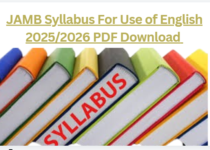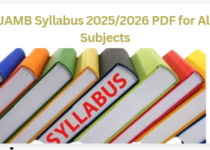JAMB Syllabus For Mathematics 2025/2026 pdf
Hi Jambite, great news for those looking for the JAMB Syllabus For Mathematics 2025/2026! The aim of the Unified Tertiary Matriculation Examination (UTME) syllabus in Mathematics is to prepare candidates for the Board’s examination.
The syllabus tests key objectives: acquiring computational and manipulative skills, developing precise logical reasoning, interpreting graphs and data, and applying mathematical concepts to everyday life.
I have organized the topics in the JAMB Mathematics syllabus into sections for easier navigation. I encourage you to study each topic thoroughly, as JAMB questions will directly reflect the syllabus. Think of your syllabus as a map guiding you to success. Here’s the table of contents:
READ ALSO:JAMB Syllabus For Use of English 2025/2026 PDF Download
Syllabus Overview
| Examination Type | UTME / Direct Entry |
|---|---|
| Examination Year | 2024/2025 |
| Syllabus | Mathematics |
| File Format | |
| File Size | 256 KB |
JAMB Syllabus For Mathematics 2025/2026
The JAMB Mathematics Syllabus is divided into sections, each focusing on specific mathematical areas: Number and Numeration, Algebra, Geometry, Trigonometry, and Calculus.
Candidates should utilize various study resources, such as textbooks, reference materials, and online platforms aligned with the syllabus. These resources will help deepen understanding.
It’s crucial to remember that Mathematics requires more than memorization—it’s about practical problem-solving. Candidates should actively solve problems, work through examples, and grasp the step-by-step solutions.
General Objectives
- Acquire computational and manipulative skills;
- Develop precise, logical and formal reasoning skills;
- Develop deductive skills in interpretation of graphs, diagrams and data
- Apply mathematical concepts to resolve issues in daily living.
| TOPICS/CONTENTS/NOTES | OBJECTIVES |
|---|---|
| SECTION I: NUMBER AND NUMERATION | |
| 1. Number Bases: (a) Operations in different number bases from 2 to 10; (b) Conversion from one base to another including fractional parts. | Candidates should be able to: i. Perform four basic operations (x, +, -, ÷); ii. Convert one base to another; iii. Perform operations in modulo arithmetic. |
| 2. Fractions, Decimals, Approximations and Percentages: (a) Fractions and decimals; (b) Significant figures; (c) Decimal places; (d) Percentage errors; (e) Simple interest; (f) Profit and loss percent; (g) Ratio, proportion, and rate; (h) Shares and value-added tax (VAT). | Candidates should be able to: i. Perform basic operations (x, +, -, ÷) on fractions and decimals; ii. Express to specified number of significant figures and decimal places; iii. Calculate simple interest, profit and loss percent, ratio, proportion, rate, and percentage error; iv. Solve problems involving shares and VAT. |
| 3. Indices, Logarithms, and Surds: (a) Laws of indices; (b) Equations involving indices; (c) Standard form; (d) Laws of logarithms; (e) Logarithm of any positive number to a given base; (f) Change of bases in logarithms and application; (g) Relationship between indices and logarithms; (h) Surds. | Candidates should be able to: i. Apply the laws of indices in calculations; ii. Establish the relationship between indices and logarithms in solving problems; iii. Solve equations involving indices; iv. Solve problems in different bases in logarithms; v. Simplify and rationalize surds; vi. Perform basic operations on surds. |
| 4. Sets: (a) Types of sets; (b) Algebra of sets; (c) Venn diagrams and their applications. | Candidates should be able to: i. Identify types of sets (empty, universal, complements, subsets, finite, infinite, disjoint sets); ii. Solve problems involving cardinality of sets; iii. Solve set problems using symbols; iv. Use Venn diagrams to solve problems involving not more than 3 sets. |
| SECTION II: ALGEBRA | |
| 1. Polynomials: (a) Change of subject of formula; (b) Multiplication and division of polynomials; (c) Factorization of polynomials of degree not exceeding 3; (d) Roots of polynomials not exceeding degree 3; (e) Factor and remainder theorems; (f) Simultaneous equations including one linear and one quadratic; (g) Graphs of polynomials of degree not greater than 3. | Candidates should be able to: i. Find the subject of the formula of a given equation; ii. Apply factor and remainder theorem to factorize a given expression; iii. Multiply, divide polynomials of degree not more than 3 and determine values of defined and undefined expressions; iv. Factorize by regrouping difference of two squares, perfect squares, and cubic expressions; v. Solve simultaneous equations – one linear, one quadratic; vi. Interpret graphs of polynomials including applications to maximum and minimum values. |
| 2. Variation: (a) Direct; (b) Inverse; (c) Joint; (d) Partial; (e) Percentage increase and decrease. | Candidates should be able to: i. Solve problems involving direct, inverse, joint, and partial variations; ii. Solve problems on percentage increase and decrease in variation. |
| 3. Inequalities: (a) Analytical and graphical solutions of linear inequalities; (b) Quadratic inequalities with integral roots only. | Candidates should be able to: i. Solve problems on linear and quadratic inequalities; ii. Interpret graphs of inequalities. |
Download JAMB Syllabus for Mathematics 2025/2026
FAQs
Yes, JAMB has released the 2025 syllabus which can be downloaded on this page or on the JAMB portal.
This depends on your course of study. Mathematics is compulsory for most science subjects like Engineering.
4 subjects. English language is compulsory for all candidates.
No, the JAMB syllabus is not always the same every year. The syllabus is subject to modification at any year.
Yes, JAMB follows its syllabus. However, you can read broad and prepare thoroughly for the forthcoming exams.

